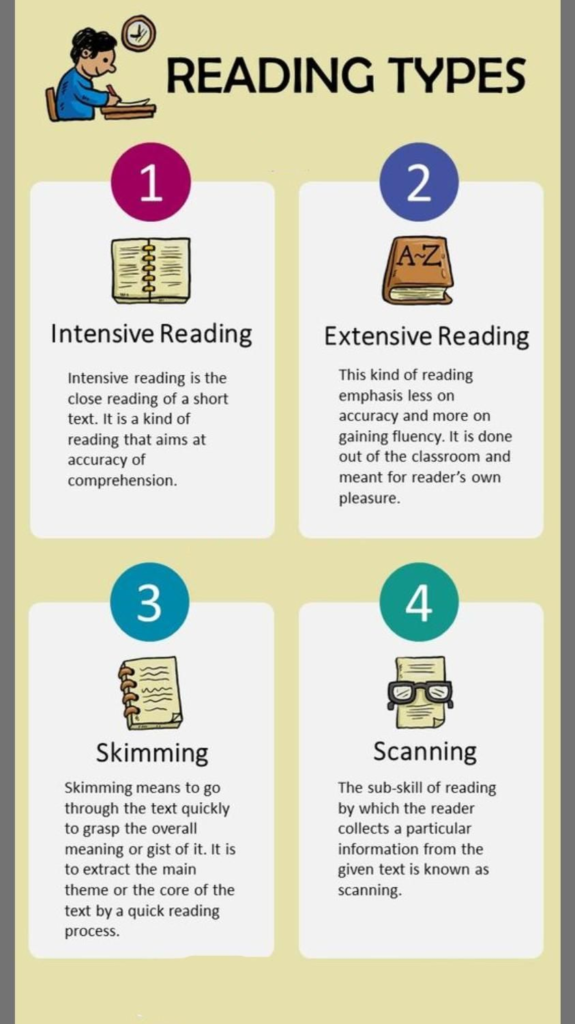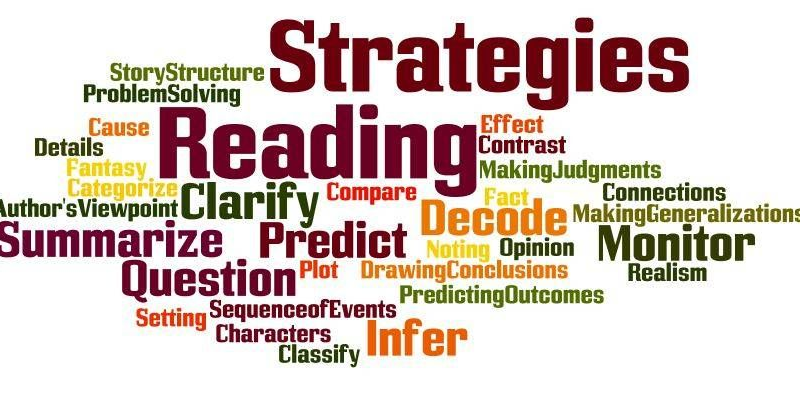Read Smart Read Right
Reading is a multifaceted skill that extends beyond the simple act of decoding written words. Different contexts and purposes require distinct reading techniques to extract the maximum benefit from the text. It is an indispensable skill in our information-driven world. It’s a nuanced and multifaceted endeavor that demands a versatile set of techniques to suit different contexts and purposes. The intricate world of reading techniques and the art of reading goes beyond mere consumption. It is an active engagement with information, an intellectual journey, and a means of personal and professional empowerment.
As we navigate through the diverse realms of reading, it becomes apparent that each type of reading serves a unique purpose, requiring specific techniques to extract maximum value from the written material. From the rapid sweeps of skimming to the immersive depths of reflective reading, each approach contributes to a reader’s toolkit, offering a spectrum of skills that can be adapted to various scenarios. In an era where information is abundant and technology shapes how we consume content, understanding different reading methods becomes not just a skill but a necessity for navigating the complexities of our interconnected world.
—Reading is an intellectual journey, and a means of personal and professional empowerment.—
This exploration aims to equip readers with the knowledge and skills needed to not only decode words but to truly engage with the vast array of written material available, fostering a deeper appreciation for the art and science of reading. Understanding these reading approaches can enhance comprehension, critical thinking, and overall engagement with written material.

Purpose: Skimming is employed when the goal is to quickly grasp the main idea or obtain a general overview of the text.
Technique: Readers employ a rapid reading pace, focusing on headings, subheadings, keywords, and the opening and closing paragraphs. The aim is to identify the key points without delving into the details.
Skimming is particularly useful for previewing textbooks, articles, or reports before engaging in more detailed reading. It aids in decision-making about whether the text is relevant to one’s needs.
Purpose: Scanning is employed when specific information or details within a text need to be located quickly.
Technique: Readers scan the text rapidly, searching for particular words, phrases, or numbers. It involves moving the eyes quickly over the text to pinpoint the required information without reading every word.
Scanning is commonly used when looking for a particular piece of information in a directory, index, or any document with well-defined sections.
Purpose: Extensive reading is undertaken to gain a broad understanding of a topic or simply to enjoy reading without focusing on every detail.
Technique: Readers cover longer passages or entire texts, emphasizing comprehension of the overall content rather than specific details. This approach is common in leisure reading or when trying to develop a general understanding of a subject.
Extensive reading enhances vocabulary, fluency, and general knowledge.
Purpose: Intensive reading is employed when a thorough understanding and analysis of a text are required.
Technique: Readers engage in careful, detail-oriented reading, paying close attention to every word, sentence, and paragraph. Re-reading may be necessary to grasp complex concepts or nuances.
Intensive reading is essential for academic texts, legal documents, and any material that demands deep comprehension.
Purpose: Critical reading involves evaluating and analyzing a text, considering its strengths and weaknesses.
Technique: Readers question the author’s arguments, identify biases, and assess the evidence provided. Critical readers may compare the text with other sources and challenge the author’s conclusions.
Critical reading is crucial in academic and professional settings where the ability to assess the validity of information is paramount.
Purpose: Analytical reading delves deeper into the structure and components of a text.
Technique: Readers examine the relationships between ideas, understand the organization of the text, and evaluate the author’s style. This approach aims to unravel the underlying structure and purpose of the text.
Analytical reading is common in literary analysis, academic research, and any context where a nuanced understanding of the text is essential.
Literal Reading
Purpose: Literal reading aims to understand the information explicitly stated in the text.
Technique: Readers focus on the surface meaning of words and sentences without seeking deeper interpretations. This approach is straightforward and is commonly used when extracting factual information.
Literal reading is essential in comprehending instructional manuals, procedural documents, or any text where precision is crucial.
Purpose: Inferential reading involves drawing conclusions or making inferences based on the information provided.
Technique: Readers go beyond the explicit content to understand implied meanings and connections. This approach requires critical thinking and the ability to connect dots within the text.
Inferential reading is vital for developing higher-order thinking skills and understanding complex narratives.
Reflective Reading:
Purpose: Reflective reading involves engaging deeply with the text, often for personal or intellectual growth.
Technique: Readers contemplate the ideas presented, relate them to personal experiences, and consider their broader implications. Reflective reading fosters self-discovery and a deeper connection with the material.
Reflective reading is often associated with philosophical or self-help literature, encouraging readers to introspect and apply the concepts to their lives.
Interactive Reading
Purpose: Interactive reading involves actively engaging with the text, possibly through discussion, annotation, or other forms of interaction.
Technique: Readers respond to the text, ask questions, and discuss ideas with others. This approach fosters a dynamic and collaborative learning environment.
Interactive reading is commonly used in book clubs, academic seminars, and other settings where shared understanding and perspectives are valued.
Purpose: To quickly assess the content and structure of a text to determine its relevance.
Technique: Readers skim through headings, subheadings, and key points to determine if the material aligns with their needs or interests. This approach is often used in libraries or online databases to efficiently locate relevant resources.
Survey reading helps readers make informed decisions about whether to invest time in more in-depth reading.
Purpose: To enjoy the act of reading purely for entertainment and personal satisfaction.
Technique: Readers immerse themselves in the narrative, characters, and emotions of the text without an explicit goal of analysis. Pleasure reading can encompass various genres, from fiction to poetry, providing a break from more structured reading activities.
Pleasure reading contributes to stress reduction, relaxation, and the overall enjoyment of literature.
Purpose: To increase reading speed while maintaining comprehension.
Technique: Readers employ techniques such as minimizing subvocalization (reading aloud in one’s head), using a pointer or guide, and expanding peripheral vision to cover more words at once. Speed reading is often practiced to manage large volumes of information efficiently.
While speed reading can be a valuable skill, it may not be suitable for all types of reading, especially those requiring deep analysis.
Collaborative Reading:
Purpose: To collectively engage with a text through group discussion, collaboration, or joint analysis.
Technique: Readers share their perspectives, insights, and interpretations with others. Collaborative reading enhances understanding by incorporating diverse viewpoints and interpretations.
This approach is commonly used in educational settings, book clubs, or collaborative research projects.
Adaptive Reading:
Purpose: To adjust reading techniques based on the nature and complexity of the material.
Technique: Readers assess the characteristics of the text (length, complexity, purpose) and choose the most suitable reading technique accordingly. This adaptive approach allows for flexibility in navigating diverse reading materials.
Adaptive reading is a skill that evolves with experience, enabling readers to tailor their approach to various reading contexts.
Technological Reading:
Purpose: To engage with digital texts using electronic devices and online platforms.
Technique: Readers navigate through e-books, online articles, and multimedia content, utilizing features like hyperlinks, annotations, and search functions. Technological reading requires digital literacy skills to effectively harness the advantages of digital platforms.
Technological reading is increasingly prevalent in the modern era, influencing how individuals access and interact with information.
Empathetic Reading:
Purpose: To connect emotionally with the content, understanding characters’ perspectives and feelings.
Technique: Readers immerse themselves in the emotional aspects of the text, empathizing with characters’ experiences. This approach is common in literature, fostering emotional intelligence and a deeper connection with the narrative.
Empathetic reading encourages readers to consider different viewpoints and enhances their understanding of human experiences.
Multimodal Reading:
Purpose: To comprehend texts that incorporate multiple modes of communication, such as images, videos, and interactive elements.
Technique: Readers integrate visual and auditory cues alongside traditional written content. Multimodal reading is prevalent in digital media, educational materials, and online platforms, requiring readers to navigate diverse forms of information simultaneously.
Multimodal reading reflects the evolving nature of communication in the digital age.
Understanding the various types of reading techniques equips readers with a versatile set of skills that can be applied in different contexts. Whether the goal is to quickly extract information, thoroughly analyze a text, or engage deeply with its content, employing the right reading technique enhances comprehension and enriches the overall reading experience. As readers become proficient in navigating different types of reading, they empower themselves to extract maximum value from the vast array of written material available to them.
Cite this article in APA as: George, S. Read smart read right. (2024, January 18). Information Matters, Vol. 4, Issue 1. https://informationmatters.org/2024/01/read-smart-read-right/
Author
-
I am a high school librarian with over 10 years experience in several school in Delhi. I have worked across boards like International Baccalaureate, IGCSE, and CBSE. My passion is writing and research about academic library, mainly school library.
View all posts





